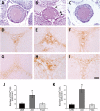Development of heterotopic transplantation of the testis with the epididymis to evaluate an aspect of testicular immunology in rats
- PMID: 28475594
- PMCID: PMC5419600
- DOI: 10.1371/journal.pone.0177067
Development of heterotopic transplantation of the testis with the epididymis to evaluate an aspect of testicular immunology in rats
Abstract
Transplantation of testicular cells and tissues has been studied for the investigation of immunology of the testis, which is an immunologically privileged organ. However, reports of transplant of the testis at organ level have been extremely limited because of technical difficulties of the orthotopic testis transplantation (OTT) in experimental animals. In the present study, we developed a new and simple model of the heterotopic testis transplantation (HTT), which is donor testis transplantation into the cervical region of recipients, in a syngeneic model in rats [donor Lewis (LEW) graft to LEW recipient]. The duration of HTT was significantly shorter and success rate higher than that of OTT. To histologically evaluate HTT, the local immune responses were compared among the syngeneic model, an acute rejection allogeneic model [donor Augustus Copenhagen Irish (ACI) graft to LEW recipient] and a chronic rejection allogeneic model (donor F344 graft to LEW recipient) at postoperative day 3. We found that allogeneic ACI grafts resulted in mild and not severe orchitic lesions, whereas immune responses of allogeneic F344 grafts seemed intact and were not significantly different from those of syngeneic LEW grafts. These results suggest that our new operative procedure will be useful in future for the investigation of the testicular immunology.
Conflict of interest statement
Figures









Similar articles
-
Prolonged cold ischemic times and less donor-recipient histocompatibility accelerate graft vascular disease.Transplant Proc. 2011 Dec;43(10):3863-8. doi: 10.1016/j.transproceed.2011.09.040. Transplant Proc. 2011. PMID: 22172861
-
Mixed allogeneic chimerism prevents obstructive airway disease in a rat heterotopic tracheal transplant model.J Heart Lung Transplant. 1998 Aug;17(8):801-8. J Heart Lung Transplant. 1998. PMID: 9730430
-
A new modified technique for heterotopic femoral heart transplantation in rats.J Surg Res. 2007 May 15;139(2):157-63. doi: 10.1016/j.jss.2006.12.543. Epub 2007 Mar 8. J Surg Res. 2007. PMID: 17349659
-
Alloreactivity as therapeutic principle in the treatment of hematologic malignancies. Studies of clinical and immunologic aspects of allogeneic hematopoietic cell transplantation with nonmyeloablative conditioning.Dan Med Bull. 2007 May;54(2):112-39. Dan Med Bull. 2007. PMID: 17521527 Review.
-
Tissue microcircumstances for leukocytic infiltration into the testis and epididymis in mice.J Reprod Immunol. 2005 Oct;67(1-2):57-67. doi: 10.1016/j.jri.2005.06.007. Epub 2005 Aug 18. J Reprod Immunol. 2005. PMID: 16111766 Review.
Cited by
-
Immunological microenvironment in the testis.Reprod Med Biol. 2019 Aug 29;19(1):24-31. doi: 10.1002/rmb2.12293. eCollection 2020 Jan. Reprod Med Biol. 2019. PMID: 31956282 Free PMC article. Review.
References
-
- Johnson L, Suggs LC, Norton YM, Zeh WC. Effect of developmental age or time after transplantation on Sertoli cell number and testicular size in inbred Fischer rats. Biol Reprod. 1996;54: 948–959. - PubMed
-
- Schlatt S, Kim SS, Gosden R. Spermatogenesis and steroidogenesis in mouse, hamster and monkey testicular tissue after cryopreservation and heterotopic grafting to castrated hosts. Reproduction. 2002;124: 339–346. - PubMed
MeSH terms
LinkOut - more resources
Full Text Sources
Other Literature Sources

